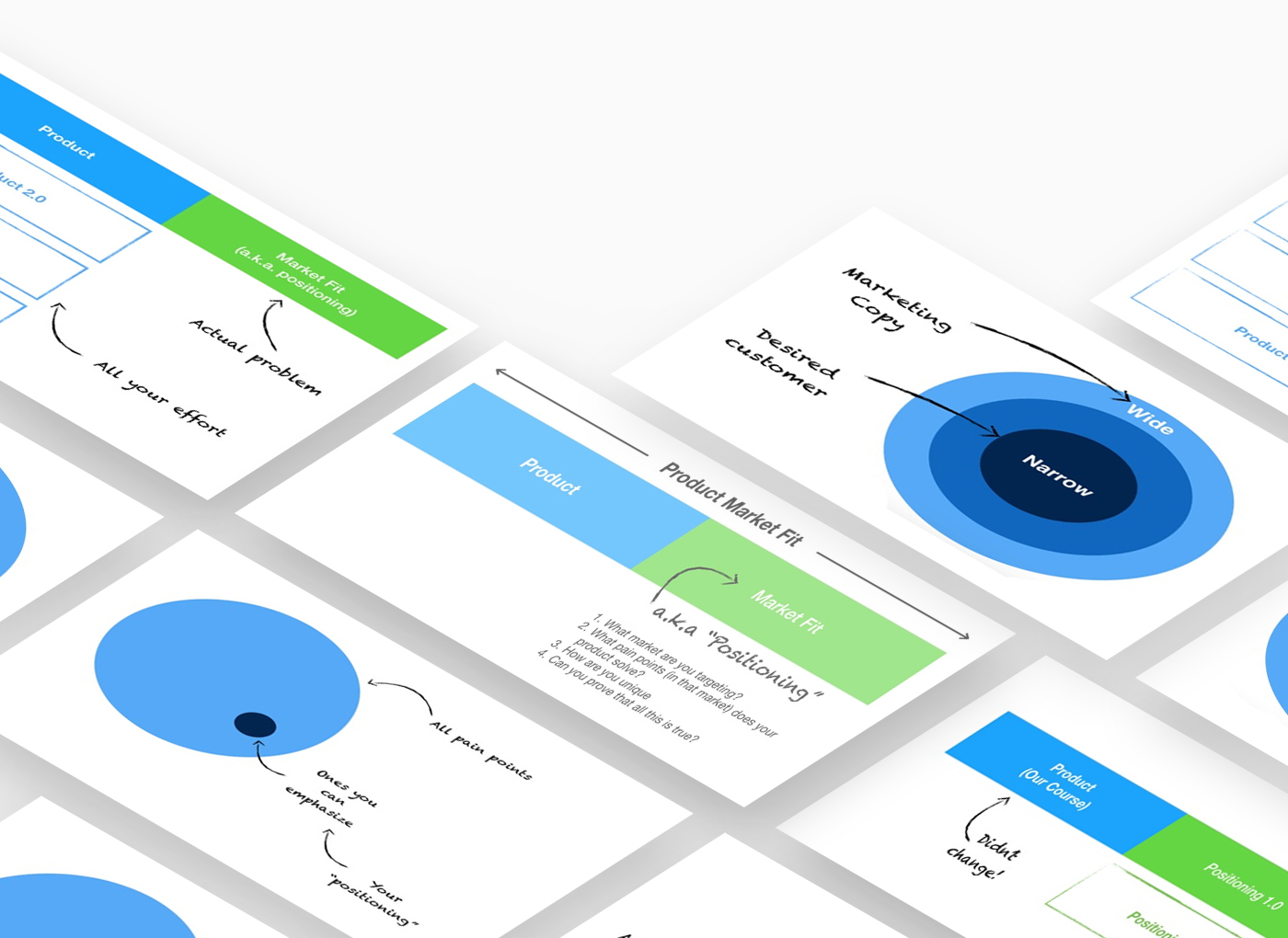This article is not about content marketing. It’s about a key learning we’ve acquired after years of doing marketing:
If your positioning is wrong, your marketing will fail.
…including content marketing.
And if your marketing fails, you’ll fail in general, because you won’t have a repeatable, scalable acquisition channel.
We’ve learned this lesson time and time again, with our own businesses, and with clients’ businesses. So we wanted to finally share our thoughts on this.
First we need to define what the heck we mean by positioning.
What Is Positioning in Marketing?
Here is our definition of positioning with respect to product market fit: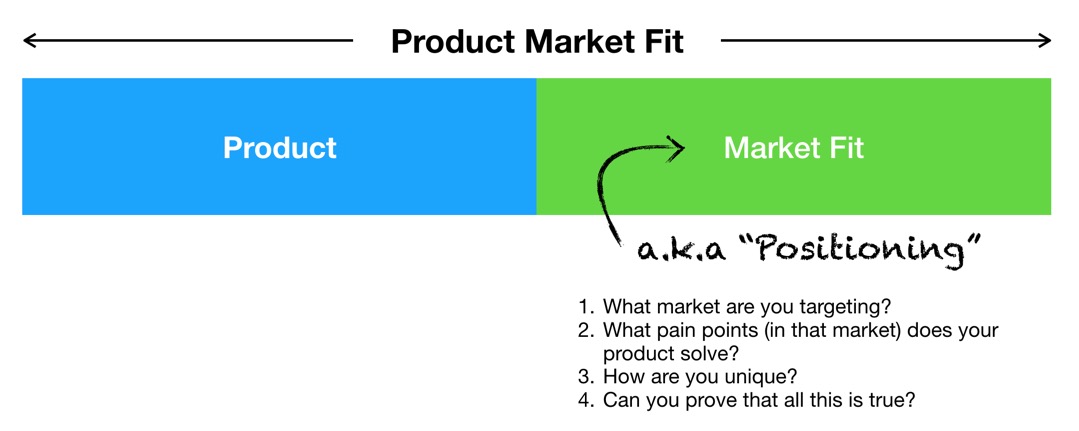
In other words, positioning is the “market fit” part of “product market fit” and it’s likely the part you are ignoring.
Most people when searching for product market fit, focus on the product:
- Let’s release an MVP (product) to see if people are interested
- Not enough people are signing up? Let’s add features to the product!
- Still not enough signups? Let’s pivot and change the product.
Then, for the “market fit” part, they just state a high level overview of their target customer and call it a day:
- Our new CRM targets sales managers
- Our dev shop targets series A and B startups
- Our ecommerce store caters to millennial women
- My consulting practice offers copywriting services to small businesses that need copywriting
This is not good enough. The above statements are just general target markets. But what about how your offering is perceived by the market?
- Who do customers think your product/service is for?
- What do customers think makes you unique?
- What pain points do they think you solve?
- How credible do they perceive you to be?
That’s positioning.
And there’s a lot of detail involved in getting it right that, if ignored, will lead you to throw your hands up and blame the product if you don’t get enough sales (interpreted as not achieving product-market fit).
But the problem may not be in the product itself, but the subtleties of positioning the product that you get wrong.
Many companies ignore this positioning mistake, and as a result, end up tweaking the product over and over again and spinning their wheels.
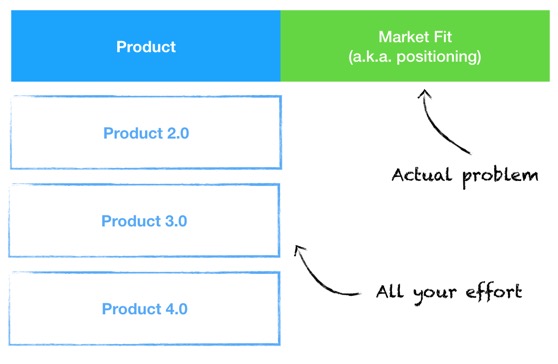
To explain this, we’ll first go over our own case study of a positioning “fail”, where by simply changing the sales copy and not touching the product at all, we were able to increase sales 300% for our product.
We’ll then go over the 4 aspects of positioning you need to get right.
Positioning Failure Example: Our Content Marketing Course
You can find a link to our content marketing course in our nav bar. We love this product and genuinely think it’s one of the best content marketing resources around.
But the first time we released it, it was a failure.
We wrote all about that here, but in short, out of roughly 6000 people on our email list, around 10 bought. That’s an 0.16% conversion rate.
Typically online courses released to an email list should sell around 1% – 2% in this space (we know this from just talking to folks in the space and from what happened when we fixed our positioning mistake).
Aside: In the end this was a wonderful failure, as it led to the launch of our agency, which is doing really well, despite it being a hell of a lot more work than a course business, but that’s a debate for another time.
Fast forward one year and we re-released our course via the landing page linked to in the nav bar and, with only a slight increase in email list size, we sold over 65 seats, for roughly a 1% conversion rate from our list.
Our Positioning Strategy Change
We did not change the product at all. It’s literally the exact same product. We just changed its positioning. Literally speaking, we changed how we positioned what the product is, who its for, and why it’s unique.
We flipped the diagram above to this:
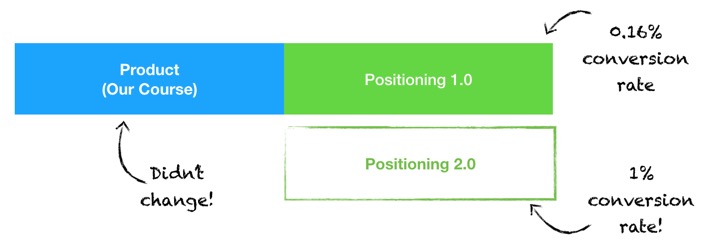
There were 2 key changes in positioning.
(1) We changed from “for the company” to “for the person”
This was the single biggest change in positioning. Our previous sales page headline was this:

What do you notice about how this product is positioned?
It’s all about benefits to a company, not a person.
- “Drive qualified leads”
- “Specifically to help B2B companies”
This was not an accident. We did this extremely intentionally. In fact, we thought we were geniuses for doing it.
But we were dead wrong.
How do we know? After our failure, we emailed a survey out to folks as well as got on the phone with a few people we knew and asked them why they didn’t buy.
A theme emerged where more than one person told us this: “I don’t really care about taking a course so I can help my company. I want to take a course to help myself.”
Woah. What the heck does that mean?
We dug in deeper.
It turns out marketers wanted to learn so that they could be awesome content marketers and drive traffic to any business. Not the business they happen to work for (or be working on) right at that moment.
In other words, they didn’t actually care about driving leads to the business they work for. Strange at is sounds, that’s what we learned. What they cared about is being great content marketers.
Things like “driving leads” was just some tactic along the way that would get them to their goal: be great.
But the sales page didn’t position the product like that.
Look at the opening sentence:

It’s literally written to the company.
This absolutely didn’t resonate with our readers. One person told us on the phone he just started skimming instead of reading.
(2) B2B vs any business
Compounding the “for the company” positioning, was our failed hypothesis that we could create uniqueness in the market place by positioning our product as “B2B” only.
This was another a total miss.
Readers told us that they wanted to buy our course really badly but when they saw this page they immediately ruled themselves out because they didn’t want to only learn B2B content marketing.
In fact one content marketer who worked at a B2B company said they didn’t buy because they wanted the option to apply it any company in the future. Wow.
Another reader bought the course, said she absolutely loved it, but told us on the phone she almost didn’t buy because she was going to use it for B2C but decided screw it, and wanted it bad enough to just buy anyways. Wow again.
B2B only was a totally unnecessary and forced positioning failure. Our strategies can totally apply to B2C companies, but we thought B2B would give us an edge, and we were wrong.
In Contrast, Here Is Our New Positioning (That Nearly 10X-ed Our Conversion Rate)
In two of our conversations (shout out to Tam Pham and Dave Peralta), we were told “Guys, what I want the course for is to become the Michael Jordan of content marketing.”
From that line, the phrase “Become a Top 1% Content Marketer” was born:

When I used that phrase on the phone with one of the other people who gave negative feedback, he got excited and said “YES! That sounds amazing.”
And if you read our new sales page, you’ll see it’s now all focused on the individual, how to gain this knowledge for yourself, for your career growth, to give yourself options, etc.
As we mentioned we didn’t change the product at all, we just changed the positioning.
More specifically we fixed 2 positioning mistakes:
- Who we were targeting: We were positioned to businesses, we changed to positing to individuals
- What are their pain points: We were listing things like “lead generation” and “traffic quality” we changed to “grow any business” and “stop guessing with random tactics”
In our experience these are only 2 of the 4 types of positioning mistakes we see companies make.
Let’s look at all 4 mistakes. Knowing these 4 positioning mistakes can serve as a checklist for getting positioning right.
- Market: Who are you targeting?
- Pain Points: What do they care about? (And how do you help?)
- Advantage: How are you unique?
- Proof: Can you actually deliver?
Positioning Criteria #1: Who Are You Targeting?
This is clearly the most obvious of our positioning criteria. And to be fair, this is the one least likely to be “ignored” like we said at the start of the article.
But there is a lot more to this than just “We target sales managers at companies with 50+ employees”.
Namely, you need to answer this question:
How specific should your targeting be?
The Wide vs. Narrow Problem: How Specific Should Your Targeting Be?
Let’s look at two hypotheticals to understand this.
First, a development agency. Say you have an agency that is great at product development of all kinds. Well, that’s damn broad.
Should you just say “We are a product development agency?”
Should you narrow down and say “We are a mobile app development agency?”
Should you go even more specific and say “We are a mobile app development agency focusing on android firmware?”
We call this the Wide vs. Narrow positioning problem:
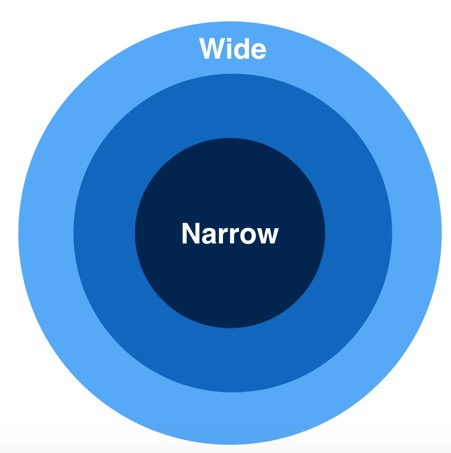
This is a really important question and we know companies struggle with it. We know this because when we take on new clients, about 50% – 75% of the time we end up exploring this question with them in the first month of our engagement.
And they openly tell us they don’t know the answer.
Second, a customer support app. Take the battle between Drift and Intercom for example.
Drift decided (and it’s working for them), to go after marketers and salespeople. Instead of building a product for multiple segments– sales, marketing, product, customer support, etc., they went all in on building the best product for these two customers.
They coined the phrase conversational marketing:
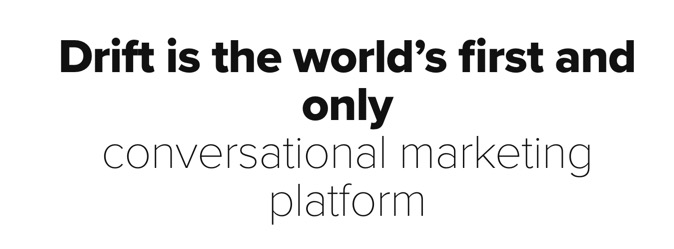
…and they position their entire product around customer acquisition, a uniquely marketing issue:
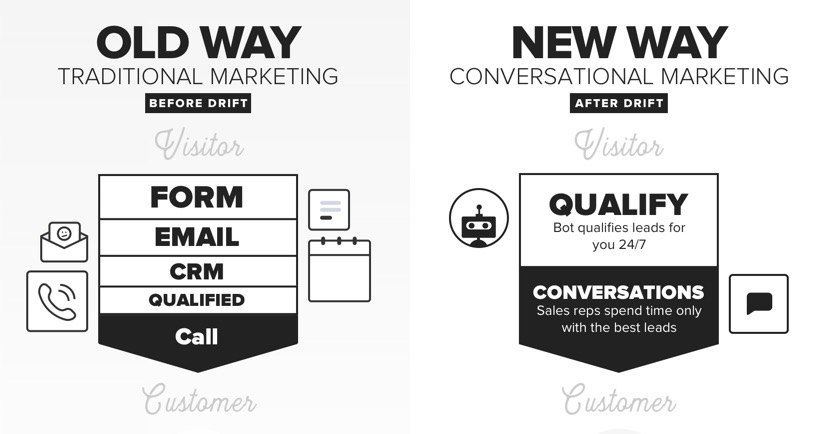
On the other hand Intercom, with — let’s be honest — an almost the identical product, has positioned it to a wider target audience (marketing, sales, support):
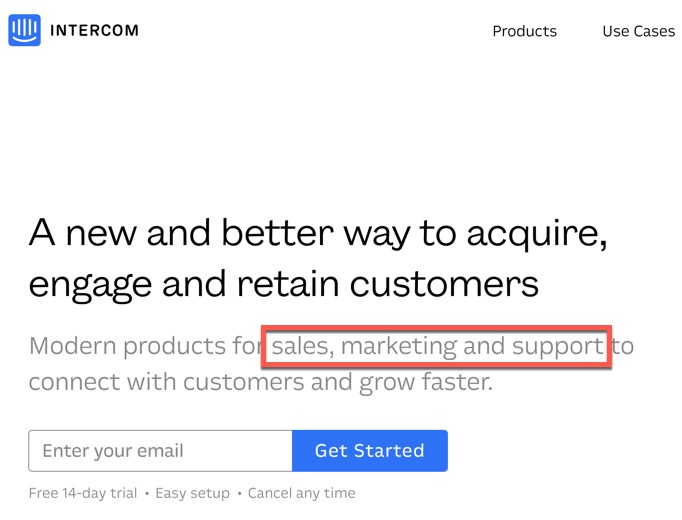
Note how important messaging is to this positioning criteria. You can use both Drift and Intercom for the same thing. But they position their products differently.
It’s a matter of emphasis.
This is exactly like the lesson from our course launch fail.
First, we positioned to B2B only (narrow) — this didn’t work. Then we switched positioning to any business type (wide) — it worked.
You may find more success going in the opposite direction: Wide to Narrow.
It’s not a matter of which is correct, it’s a matter of knowing that this is an axis you can play with.
You may get this wrong at first (we did), that’s okay, just know that you can play with this lever. You don’t have to go trying to change the product for no reason (and spend weeks/months of wasted time and money doing so).
Positioning Criteria #2: What Pain Points Are You Solving?
Once you decide on your wide vs. narrow targeting, the question to answer is:
What pain points should we position our product as solving?
You might think this is kind of obvious. For example, you build some SaaS tool like accounting software so you’re thinking, “Of course it solves usual accounting pain points”.
But it’s not so simple. Two problems can happen:
- You get the pain point wrong – This is what happened with our course and it happens with countless SaaS startups. You build software for pain point ‘X’, but users end up using it for pain point ‘Y’.
- Your product solves a bunch of pain points – Which do you pick?
Problem 1 is more of an obvious problem. Our course story above is an example of that, and you need to do the user research we discuss below to figure this out.
But Problem 2 is more subtle but still could really hurt you if you get it wrong.
Let’s look at an example.
Here are the first 3 sections on Quickbooks’ marketing homepage:
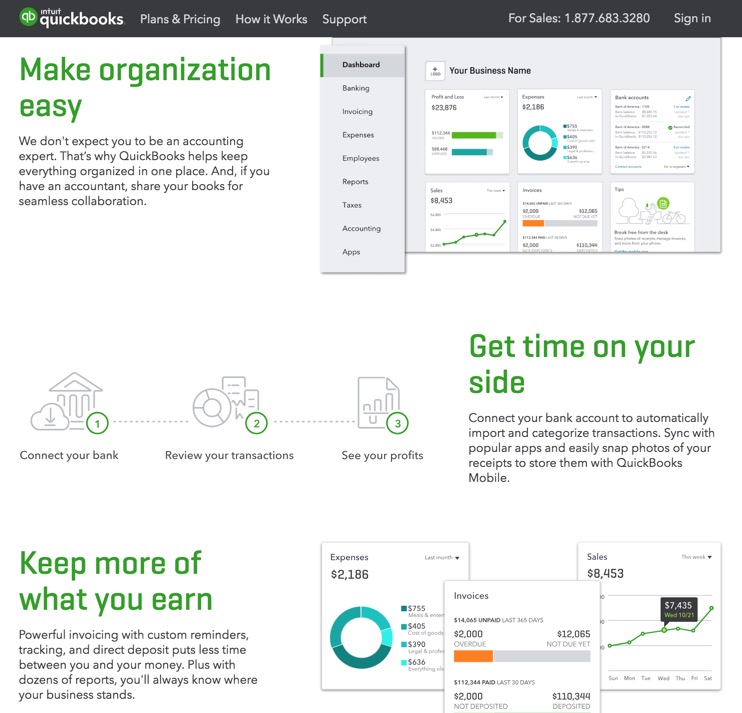
Seems normal, but here’s why getting pain point positioning down is more difficult than you think: These are only 3 of many pain points that Quickbooks could have listed.
Most (I’m tempted to say all…) products and services alleviate a lot of pain points, but you can’t reasonably emphasize all of them. By definition you have to choose which ones to emphasize.
Even if you have a giant marketing site with pages and pages of benefits, you only have one homepage, and on the homepage you only have one “hero unit” above the fold.
Which pain points (or inversely, value props) will you put on that hero unit?
That’s the pain point challenge.
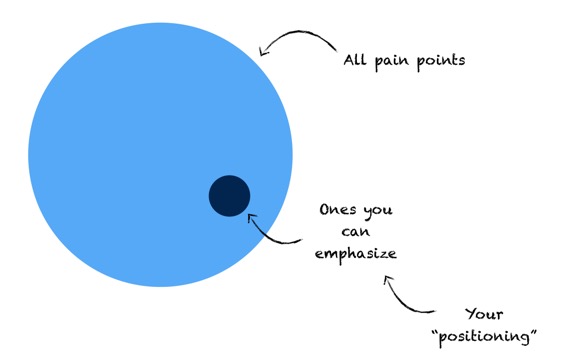
For example, we’re a customer of Quickbooks, and if you asked me to list out what pain points of mine (yes mine, Benji runs from accounting like I run from recurring meetings), I wouldn’t list out any of the ones in their homepage above.
Instead I’d say:
- Taxes – God bless Quickbooks for making it so easy to know revenue/expenses come tax time.
- Understanding – It’s let us know P&L’s from a client to client basis.
- Planning – This understanding let’s us project into the future and plan growth.
You could argue that “organize” and “keep more” in their screenshot touch on my 2 and my 3, but the point is, they — for whatever reason — chose those three pain points to mention first.
That’s fine, that’s their decision based on whatever user research they did.
You need to make the same decision.
Example: Our Agency…Picking the Biggest Pain Point
Our main business is our content marketing agency.
It solves a lot of pain points for clients:
- Content quality
- Content production (writing)
- Hiring (writers)
- Driving traffic (promotion)
- Getting leads (conversion)
- And more…
But here’s what our homepage says:
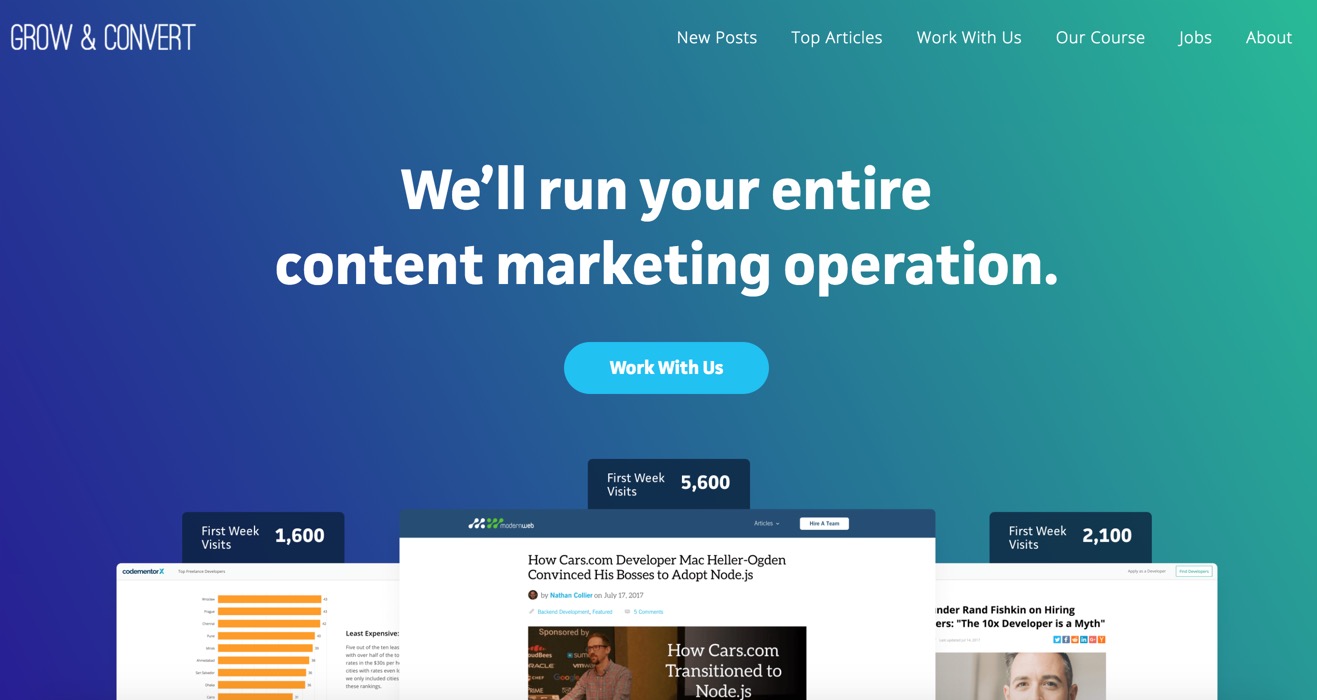
We’ve talked to many clients, they all have some mixture of the pain points above.
But we know there’s one overarching theme in their pain points: Content marketing has a lot of moving pieces and getting them to all work together is really hard.
We uniquely have a service that does everything for them, start to finish. We have writers, an editor, we promote content, we source stories, drive leads, measure and report on ROI, and more.
They can’t find that elsewhere. Most other agencies don’t do all of that and it’s almost impossible for single employee to.
So that’s the pain point and message we choose to emphasize.
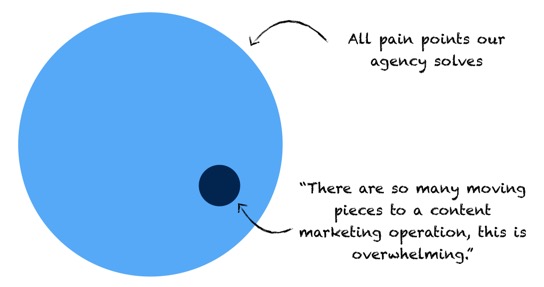
How to Know Your Customer’s Pain Points
Like many before us have said, to know which pain points to emphasize (“position” around) you need to talk to customers.
We’ve written plenty on this topic so we’ll refer you to those articles:
- You Don’t Know Your Customer And It’s Crippling Your Growth – Lessons on Conducting User Research
- How We Used A Simple Survey To Crack The Code On Our Customers
- The Best Way To Come Up With New Marketing Ideas: Ask Your Customers
- How to Conduct Customer Interviews (Even When You Don’t Have Customers)
Positioning Criteria #3: How Are You Unique?
At this point you’ve:
- Focused on a particular customer
- Understood their most important pain points
The next step is to add just a smidge of uniqueness or competitive advantage.
Why only a smidge?
Because you don’t need a ton of uniqueness. In fact being so unique that you have no competitors is usually a dangerous sign as many have written before.
This smidge of uniqueness needs to be factored into your positioning.
Yes, your product or service needs to actually have this smidge of uniqueness (see the next section: Positioning Criteria #4: Can You Deliver) but time and again we run into companies who don’t have any uniqueness in their positioning even though, after talking to them in person, we learn they actually do have some great competitive advantages.
What’s the quintessential example of this? Software development companies!
Dev shops are notorious for all sounding the same. In fact, Benji and I have this running joke that we can predict any dev shop will claim the same few things, the most common being some version of:
“We’ll take your idea to completion” or “start to finish” or “end to end”.
Like here…
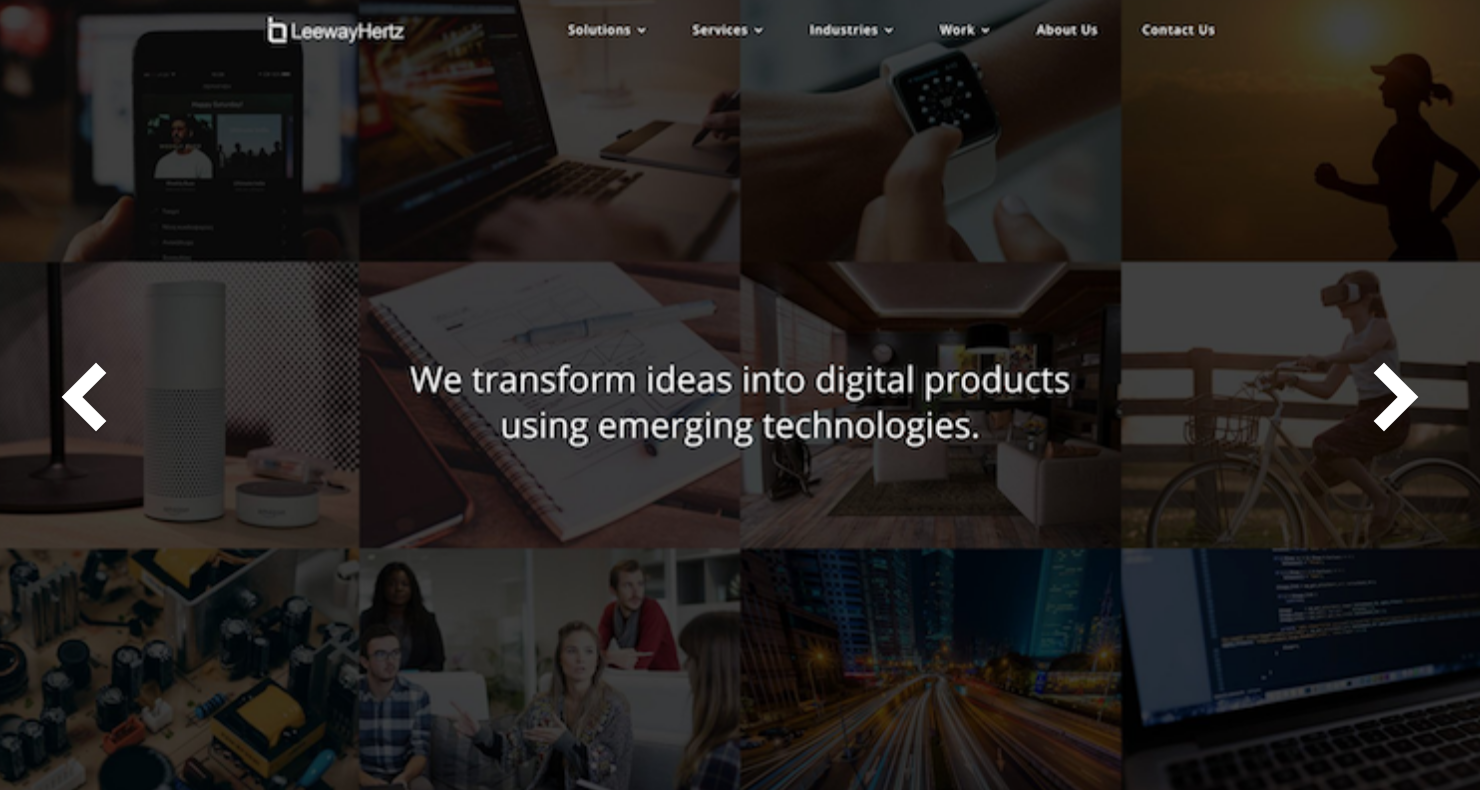
And here…

And here…

Another thing you can bank on is that they’ll all mention their “unique process” which always involves Step 1 being “get to know the business” or “listening to you”:
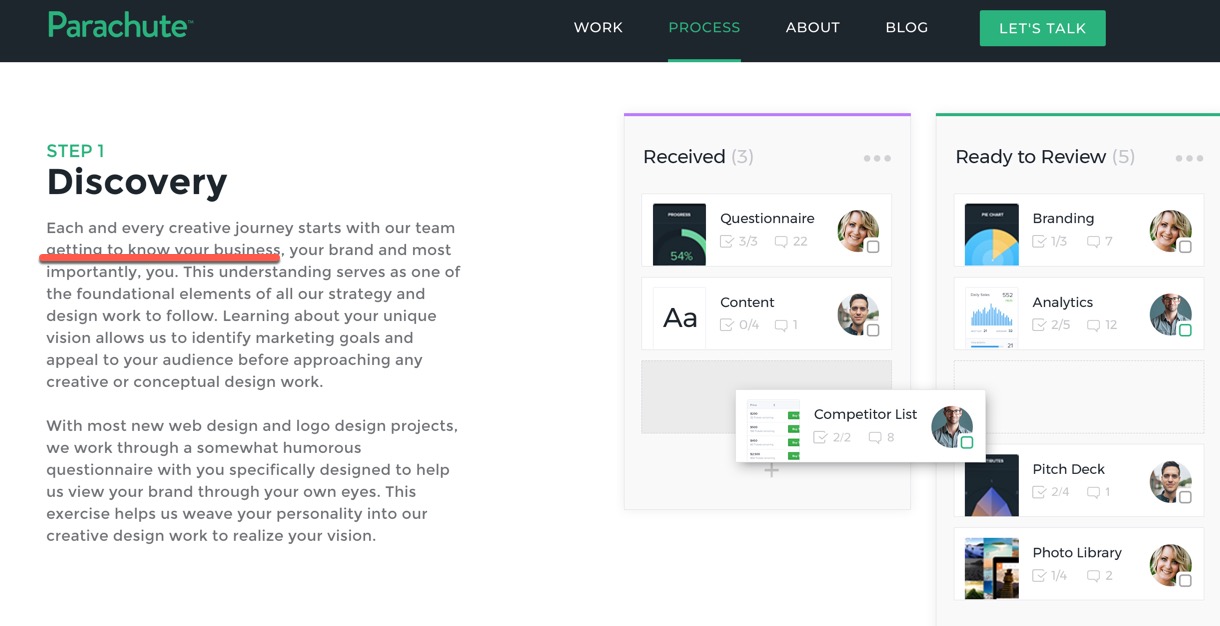
And again here…

Now, you may be thinking “But web dev isn’t that unique. It’s all the same.”
Hold your horses.
I had that same objection and brought it up to Benji when discussing this and here’s his (verbatim) response:
From Benji: “It is though. You can be the best at designing and building SaaS apps, or be the best at building sites using a specific language like Ruby on Rails. If someone was looking for that, then they’d immediately think you’re the best fit.
The problem is more that the agency isn’t surfacing what makes them unique. They’re just generalizing because they haven’t gone through the process of determining what they’re best at.”
He’s right.
If you’re in this situation, your best bet is to do steps 1 and 2 above and emphasize some of the details of your target customers and pain points.
For example…
Mentioning customer specifics:
- We are an ecommerce web design agency
- We are experts in Shopify Plus
- We do B2B websites really well
- We can design the best SaaS marketing sites
Mentioning pain point specifics:
- We specialize in SEO optimized websites
- We build websites in under 3 weeks
- We also have copywriters to write sales copy, not just design
- We can do ongoing IT maintenance of your ecommerce backend
Positioning Criteria #4: Can You Deliver? If So, Prove It.
The last criteria is the one that is most closely related to your product.
But we feel it’s still a core positioning criteria because it closes the loop on whether your company can actually deliver on the criteria above (1. Who 2. Pain points 3. Uniqueness).
This closing of the loop ensures that customers you do acquire have a positive experience and thus:
- Don’t churn as much
- Refer friends
If you get this wrong (i.e. you claim solving pain points for a target segment but can’t deliver) your bucket will be leaky and your business will likely fail. So remember:
- Churn – Customers will churn (for recurring businesses).
- Referrals – Word of mouth won’t work for you, and will eventually work against you.
So in many ways this puts limits on positioning criteria 1 and 2:
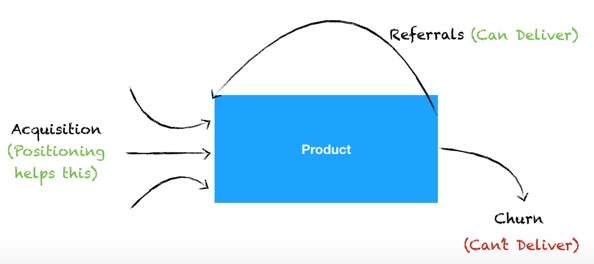
So when thinking of pain points and who you’re going to target, make sure you ask this question:
Can our product/service actually fulfill these claims?
This is where a product pivot often makes sense. The story often goes like this:
- Your initial product/market fit hypothesis failed
- You decide to do some customer research to figure out who to target and what their pain points are
- You find a burning pain point from a specific group of customers and get excited
- Uh oh, your current product or service doesn’t actually solve those pain points for those customers
Then (and only then) does it make sense to consider a product pivot.
Using some of the examples above, this would mean:
- Our course – Our course didn’t help individuals get better at content marketing, but we learned that’s a great pain point to solve, so we spend time adjusting the course to solve it.
- Quickbooks – They discover that taxes are a huge issues for their target segment but their product lacks key functionality to solve it, so they add that and reposition.
- A development agency – They discover that the exploding field of AI and Machine learning has a burning demand for software developers, so they learn or acquire those skills and offer it.
You get the idea.
We urge you to first consider what pain points your existing product/service can solve before trying to add new things to the product.
Remember, product pivots are more costly and time consuming than positioning pivots.
If You Can Deliver, Prove It
Now, assuming you can deliver, then you need to decide how you’re going to show that proof.
Specifically, we are a content marketing site after all, so let’s talk content (finally, at the end of this post).
Content is one of the best ways to prove you can deliver on your unique positioning angles and value propositions.
Here are 3 content frameworks that can prove your ability to deliver.
(1) Long Form Case Studies
This is the number one content framework for proving you can deliver on your value proposition. Case studies show that you can achieve your results. By case studies we don’t mean the cheesy marketing site case studies like “problem…solution…” but long form stories like this or this.
But case studies are not all. You can also prove you know what you’re doing in other content frameworks. We teach 6 frameworks in our course, but I want to focus on two here:
(2) How-To’s
Most how-to blog posts suck. Plain and simple. They are way too beginner and don’t have customer-content fit. Fixing that is proof you know what you’re talking about and is a great asset for your positioning goals.
(3) Opinion
Opinion pieces are controversial pieces that take a stand instead of teaching, for example this Why Marketing is the Hardest Position to Hire For article by Benji. Most crappy blogs don’t have the ability or wherewithal to produce high quality opinion pieces. Change that. Show your understanding of the subtleties of your field by writing a thoughtful piece. It will prove you know what you’re doing and that you understand the customer.
Speaking of proof, this leads me to the final step.
Final Step: Messaging vs. Positioning, Do They Match?
Positioning and messaging are not the same.
Positioning is how you want your product/service to be perceived in the market and messaging is what you actually communicate to your audience to get them to believe that.
Your messaging needs to align with your positioning, but we often see that that’s not the case.
We’re not going to give any examples to call anyone out here, but we see this all the time with clients.
They tell us they want super specific leads but their messaging is really generic. In the wide-narrow framework above, that looks like this:
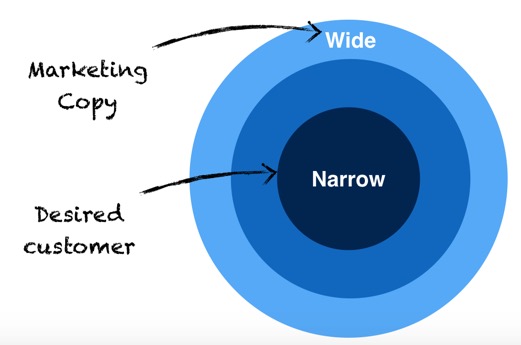
This would be like the development agency that wants consumer mobile app design projects with a website that effectively says “We’ll develop anything”. You laugh, but it’s extremely common.
So after you go through the positioning process above, including in particular the user research articles, you need to comb through your messaging and ask yourself if it aligns with what you just concluded.
- We want these super specific customers – Does the messaging align?
- We help solve this critical pain point – Do you say that anywhere?
- We are unique like this – Is that obvious?
- We have proof to back it up – Can prospects easily say this?
Positioning Podcast
Subscribe to get a link to the 22 minute podcast between Benji and Devesh about this article.

